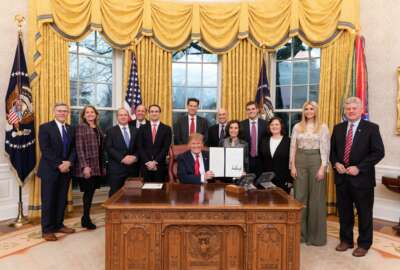

Kelvin Droegemeier, the new head of the White House's Office of Science and Technology Policy, says the United States lacks answers to basic questions about the...
President Donald Trump, through an executive order he signed last Monday, doubled down on making artificial intelligence research a top priority for the public and private sectors.
But the new head of the White House’s Office of Science and Technology Policy said the United States lacks answers to basic questions about the current state of AI research.
Kelvin Droegemeier, speaking Friday at the American Association for the Advancement of Science in Washington, said the U.S. doesn’t have a clear headcount of how many researchers and institutions are actually working on AI across the government, the private sector and non-profit sectors, and academia.
“What assets does the federal government have access to … that could be deployed in a way that would really supercharge that artificial intelligence R&D system? The answer is we don’t really have a clue. Those are very, very tough questions,” Droegemeier said.
Part of the problem, he added, is that the portfolio of AI-related fields covers everything from computer science and applied mathematics to industrial engineering, psychology and ethics.
“I think we need to go think of the American R&D enterprise as a big jigsaw puzzle. When we have our heads down, we tend to focus on a piece of that puzzle or maybe a couple of pieces — maybe our particular piece, and how a few pieces fit together,” Droegemeier said.


In order to do that, Droegemeier raised the possibility of a “quadrennial assessment” taking stock of the country’s R&D capabilities as a whole. No such assessment has ever been performed by the United States, but he added that much of the “raw material” for such a review already exists within the National Science Board, which consists of 25 members appointed by the president.
“The task is daunting, but in my view, it’s essential,” Droegemeier said, using an analogy from his prior job as a meteorology professor at the University of Oklahoma. “In much the same way that a computer weather forecast begins with knowing the current state of the atmosphere, the path toward ensuring unquestioned American dominance in R&D begins with a clear picture of today.”
Better understanding the state of American R&D stands out as the first of three “pillars” Drogemeier outlined during his keynote. Building the connective tissue between the private sector, the academic sector, nonprofit sector and private companies is the second pillar.
“The portfolio approach will allow for a thoughtful and effective allocation of federal resources, especially for basic early-stage research, which is something that government must always play a vital role in, but now viewed through the lens of work being funded in the same areas by the private sector by nonprofits and by the academic community itself.”
In 2015, for the first time in U.S. history, the private sector funded more in basic research than the federal government. Meanwhile, the universities now run 59 percent of the country’s basic research — up from 31 percent at end of World War II.
“That didn’t happen because the federal government stopped funding basic research,” Droegemeier said. “It happened because American companies have the freedom to be creative and to invest and to explore new ideas.”
Innovations that come from basic research funded by the Defense Department, the National Institutes of Health, the National Science Foundation and National Institute of Standards and Technology (NIST) have served as a jumping-off point for companies that now have a global reach.
“If you go back to 1957, when Sputnik was launched, only our federal government could mount the response to that launch. Today, it could easily be a private company and perhaps even a startup,” Droegemeier said.
Rush Holt, AAAS chief executive officer and former New Jersey congressman, in his introduction of Droegemeier, urged the Trump administration to support strained federal research budgets.
“The administration should understand – and we hope that Dr. Droegemeier will help them understand – that the funding is sub-optimal. This is no time to reduce funding for research,” Holt said.
The third pillar of the administration’s science and technology agenda focused on curbing harassment in the workplace and addressing a “longstanding” lack of diversity in STEM fields.
“The standard of behavior that we expect from the scientific community must apply everywhere research is conducted. Preventing sexual and other forms of harassment is a community-wide effort,” Droegemeier said. “I look forward to working with you and others across the enterprise to tackle this issue head-on and to fix it.”
The Trump administration, he added, also remains “laser-focused” on reducing administrative burden in the scientific field.
“You talk about waste, fraud and abuse wasted on unnecessary administrative burdens, and it runs into a few billion dollars a year that could be recaptured, if we are successfully able to reduce these unnecessary burdens.”
Copyright © 2025 Federal News Network. All rights reserved. This website is not intended for users located within the European Economic Area.
Jory Heckman is a reporter at Federal News Network covering U.S. Postal Service, IRS, big data and technology issues.
Follow @jheckmanWFED
